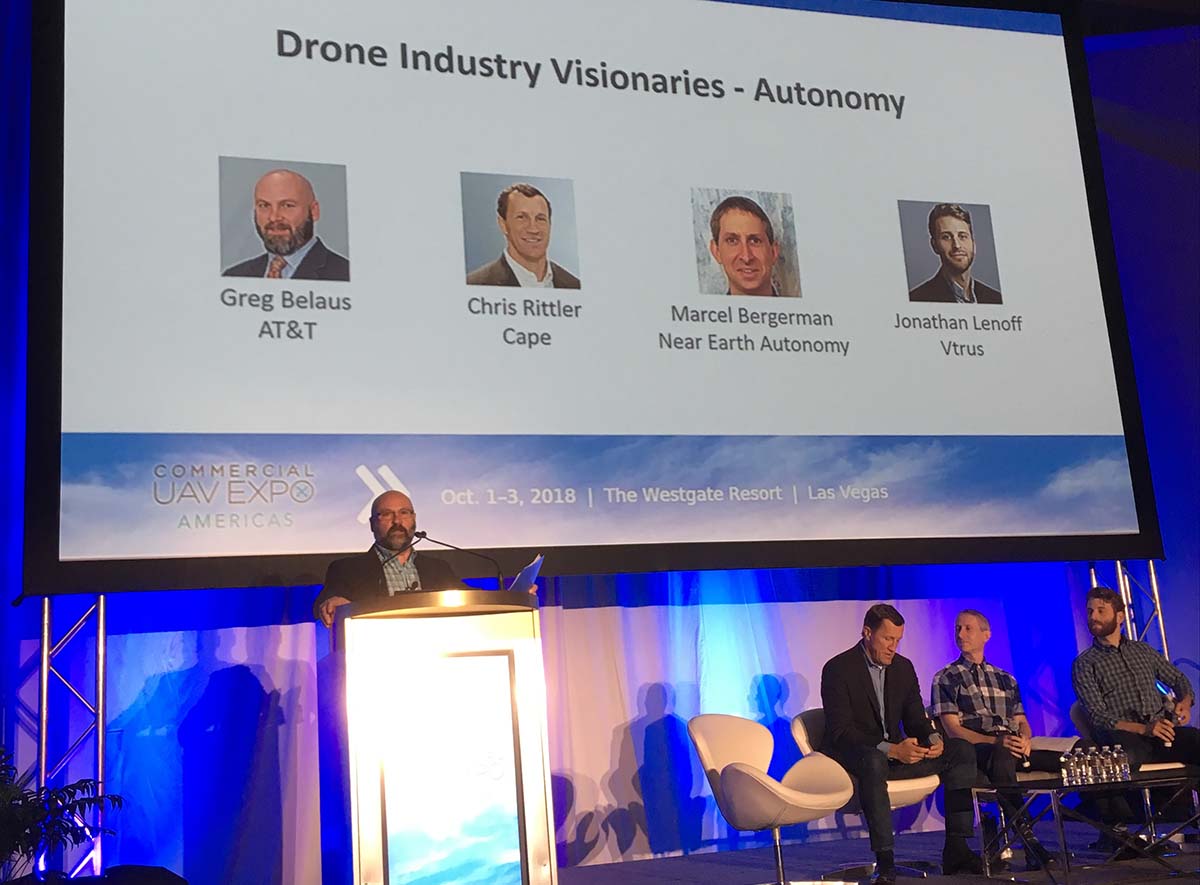On the second day of Commercial UAV Expo 2018, we attended a riveting panel discussion about the current state of autonomous drone technology and the constraints this technology is facing in terms of regulation and customer acceptance. The panelists debated and discussed the future of UAS as well as the opportunities and challenges that are just around the corner.
Moderated by Greg Belaus from AT&T, Chris Rittler from CAPE, Marcel Bergerman from Near Earth Autonomy and Jonathan Lennoff from Vtrus rounded out the panel, which got off to a quick start with all three of the panelists talking through the very different approaches they’re taking to confronting and leveraging the challenges and opportunities each of them are facing.Chris began by talking about what the San Diego Fire Department is doing with drones as part of the FAA Integration Pilot Program (IPP) to illustrate the benefits of using highly autonomous drones in disaster response situations. He advocated for the addition of the UAV to the organization’s Standard Operating Procedures (SOP) and not the other way around, forcing them to change the way they normally conduct operations.Jonathan explained how his company specializes in indoor inspections and how they are not constrained or regulated by the FAA but instead have to follow strict rules and guidelines from internal corporate policies from their customers. Their ABI Zero product is an autonomous drone designed for indoor industrial inspections, the autonomous capabilities of which could easily be utilized in other contexts and situations.Marcel explained to the audience that it’s inevitable that in the near future there will be hundreds of simultaneous autonomous inspections happening in close proximity. He explained how and why current regulation is not only good but necessary to ensure a global policy of safety first. Chris jumped in to say that the three key factors that CAPE has encountered with customers pursuing autonomy in their UAV operations are safety, cost and repeatability. He elaborated on the third factor by mentioning that their goal is to have the drone take care of the flight while they have experts to take care of the mission.Marcel came back to the theme of safety by saying “It took manned aviation 100 years to reach the current level of safety; I’m sure the drone industry can wait a few years to achieve the same level.”Chris clarified that today’s drones are semi-autonomous and that we are perhaps two years away from fully autonomous UAVs. Marcel by concurred saying that in the near future one pilot will be in a position to supervise 50 drones simultaneously and that would be the mark for full autonomy.Then the conversation took a turn towards communications and Greg, representing AT&T, intervened to say that even though today’s cell networks are not perfect, the improvement over the past few years has been tremendous. The panelists agreed but Chris took the microphone to elaborate.“Autonomy doesn’t work without communications,” he said emphatically. “Every autonomous UAV should have strict protocols in place to guarantee that, in case of a complete loss of communication, the aircraft will either land in a safe place or return to the base following a pre-established path.”Jonathan added that these safety protocols have to be embedded within the drone and that they should be completely independent of communications. Marcel agreed with Jonathan and Chris and added that these safety protocols should take into account environmental issues that might have been the cause for the loss of communication.The conversation then turned to privacy issues, as Chris cited a recent poll in which people were asked about the level of comfort they felt if they saw a drone responding to an emergency situation. Apparently, 62% of the people polled didn’t have a problem with that and the number ballooned to 88% when the individual was told that the drone was autonomous. In other words, the level of confidence in the UAV mission by the public grew as autonomy was introduced.Marcel ended the discussion saying that nothing will help more the case for autonomous drones than a few videos of drones distributing emergency supplies to disaster areas or even rescuing people from dangerous situations as a result of a natural disaster. There was wide agreement throughout the audience and the panelist with this last remark.As developments like the ones from Skyfish have proven, then autonomous capabilities of drones will only get better and more powerful over the next few years. That makes it more important than ever for us to figure out what it will mean to make this technology make sense to the public and for regulators in the United States and beyond.Subscribe
The information you submit will be stored and used to communicate with you about your interest in Commercial UAV News. To understand more about how we use and store information, please refer to our privacy policy.
October 18, 2018
Key Takeaways from the Autonomy Track of the Drone Industry Visionaries Series















Comments